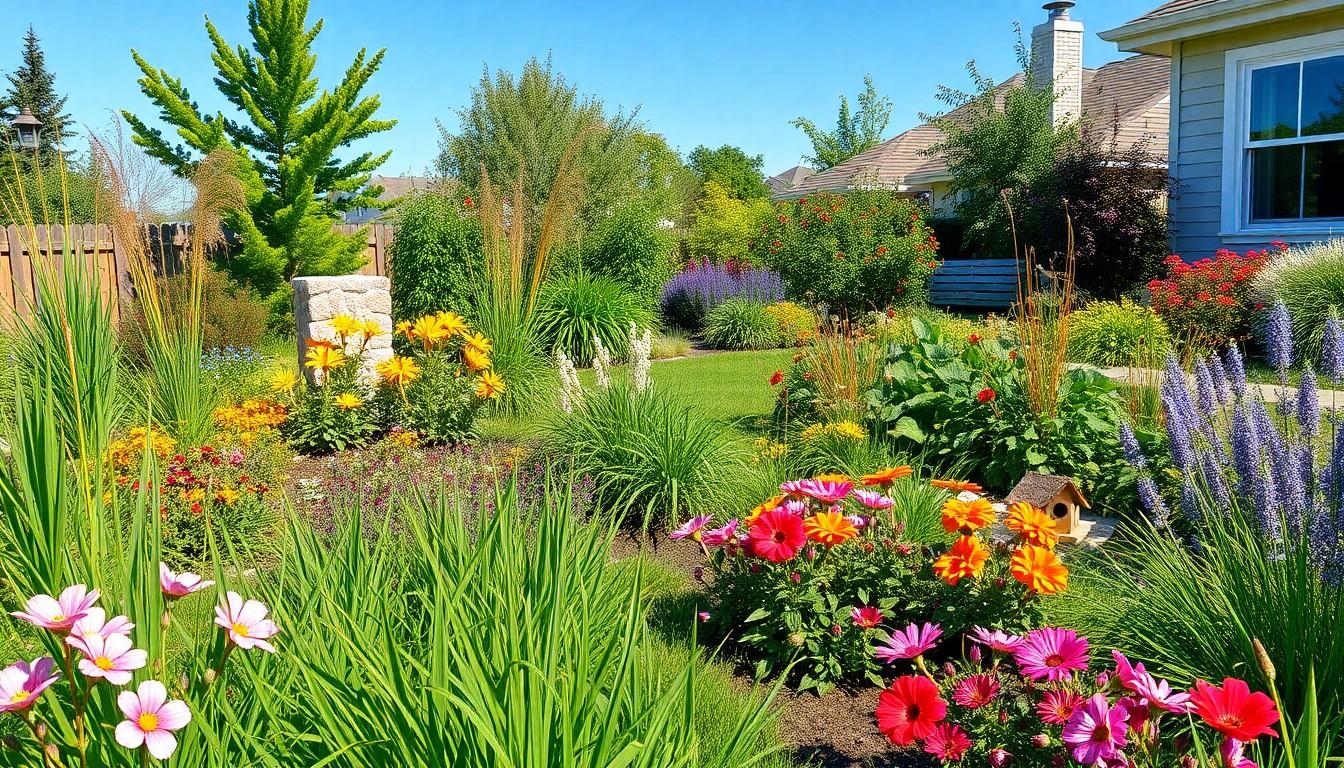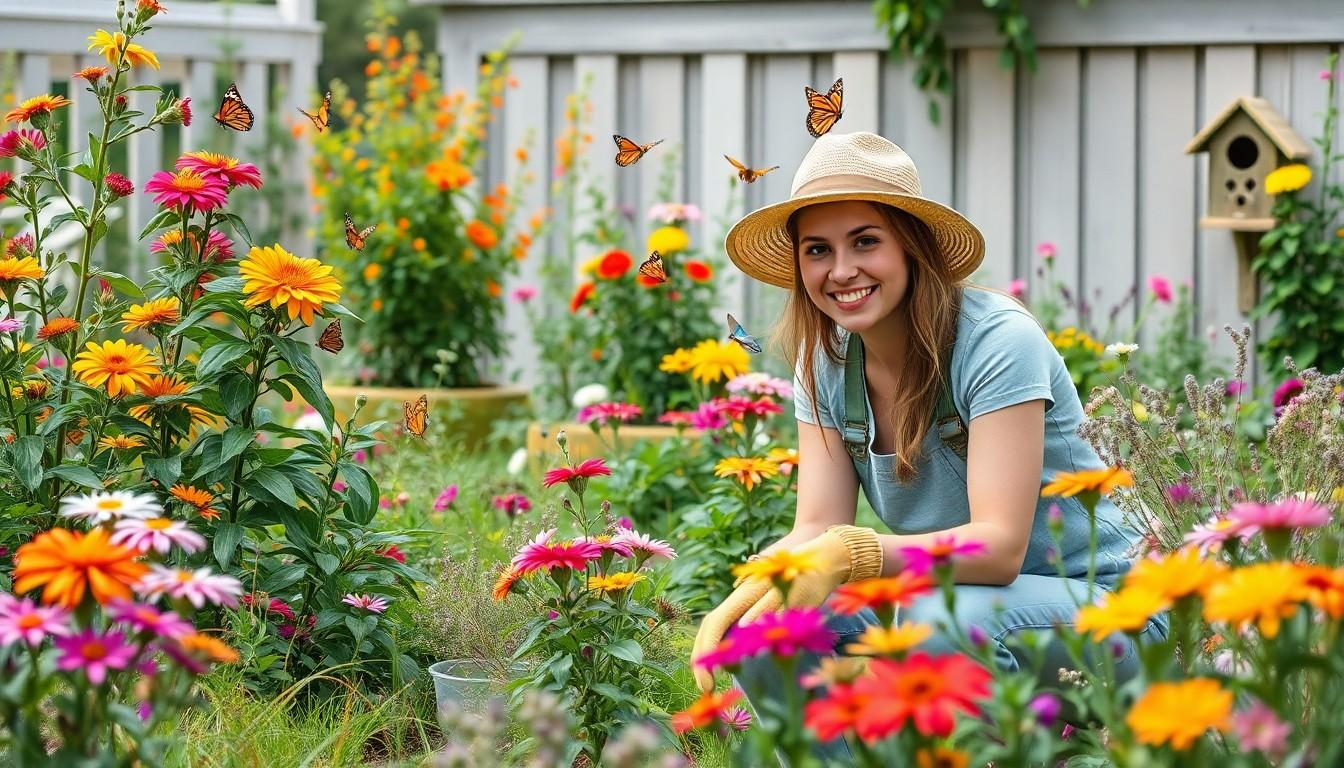Imagine stepping outside your door to find a lush, vibrant yard that looks like it belongs in a magazine. Natural yard landscaping isn’t just about aesthetics; it’s about creating a harmonious space that benefits both the environment and your sanity. Who wouldn’t want a backyard oasis that attracts butterflies instead of mosquitoes?
Natural Yard Landscaping
Natural yard landscaping emphasizes aesthetic appeal while fostering environmental balance. It transforms outdoor spaces into beautiful sanctuaries that support local ecosystems.
Key Principles of Natural Landscaping
Using native plants forms the foundation of natural landscaping. Native species require less water and minimal maintenance, making them easier to care for. Incorporating organic materials instead of synthetic fertilizers promotes soil health. Additionally, designing gardens with layers creates habitats for wildlife, encouraging biodiversity. Emphasizing sustainability also plays a crucial role, with practices like composting enriching soil quality and minimizing waste.
Benefits of Natural Yard Landscaping
Natural yard landscaping offers numerous benefits to homeowners and the environment. It enhances property value through its visual appeal. Creating habitats attracts beneficial insects and birds that help pollinate plants and control pests. Reduced water consumption results from using drought-resistant plants, saving resources. Energy efficiency increases as proper landscaping lowers home temperatures in summer. Lastly, natural landscapes provide a serene atmosphere, promoting relaxation and mental well-being.
Designing Your Natural Yard

Designing a natural yard requires careful consideration of plants and features that thrive in the local ecosystem. It emphasizes fostering biodiversity while ensuring a visually appealing landscape.
Selecting Native Plants
Choose native plants for their resilience and low maintenance needs. These plants typically require less water, making them a sustainable choice for landscaping. Look for species resilient to regional conditions and capable of attracting local wildlife. Incorporating flowers that bloom at different times provides year-round beauty and support for pollinators. Various grasses and shrubs thrive in many environments, enhancing the aesthetic while minimizing environmental impact. Ensure the selected plants are well-suited to the yard’s soil and sun exposure, allowing for healthy growth and an inviting ambiance.
Creating Eco-Friendly Features
Integrate eco-friendly features throughout the yard design. Consider adding rain gardens to manage stormwater and filter pollutants naturally. These gardens capture runoff, allowing water to infiltrate the ground and reduce erosion. Mulching around plants retains moisture while suppressing weeds, creating a healthier garden ecosystem. Install birdhouses and bat boxes to attract natural pest controllers, enhancing the balance of species in the area. Creating paths with permeable materials allows rainwater to penetrate while providing access. These elements contribute to an environmentally conscious landscape that promotes sustainability.
Maintenance Tips for Natural Landscapes
Natural yard landscapes require specific care to maintain their beauty and ecological function. Adopting sustainable practices and seasonal care routines ensures optimal growth and resilience.
Sustainable Practices
Utilizing organic fertilizers boosts soil health without harmful chemicals. Incorporating compost enriches the soil, enhancing nutrient content and moisture retention. Watering infrequently encourages deep root growth, making plants more drought-resistant. Mulching effectively suppresses weeds, reduces erosion, and retains soil moisture. Introducing beneficial insects, such as ladybugs and lacewings, enhances natural pest control. Implementing rain barrels captures rainwater for irrigation, promoting efficient water use. Opting for native plants minimizes resources needed for upkeep and encourages local wildlife attraction.
Seasonal Care
Springtime prompts a review of plant health, encouraging regular pruning to stimulate growth. Summer entails monitoring water needs, ensuring native plants thrive even during dry spells. Fall represents a time for mulching to protect roots and maintain soil temperature. Winter demands an inspection of landscapes, tackling any damage from snow or frost. Adjustments may involve additional protection for sensitive plants. Every season contributes to the ongoing vitality of a natural landscape, reinforcing its resilience and beauty.
Impact on Local Wildlife
Natural yard landscaping creates a welcoming habitat for local wildlife. It plays a crucial role in supporting biodiversity and enhancing ecosystem health.
Attracting Pollinators
Creating a diverse plant landscape draws in essential pollinators like bees and butterflies. These insects thrive on native flowers that bloom throughout various seasons. Utilizing plants such as coneflowers, milkweeds, and asters attracts various pollinator species. Pollinators facilitate plant reproduction, helping to increase the growth of flora in the area. Maintaining a consistent food source ensures these vital creatures visit regularly. By integrating flowering plants into the landscape, homeowners contribute to a healthier ecosystem.
Supporting Local Ecosystems
Natural landscaping supports vital ecosystems by providing habitats for numerous species. Maintaining a varied plant selection accommodates different bird species, insects, and mammals. Incorporating features such as brush piles or native shrubs offers shelter and nesting sites. Ground cover plants stabilize soil, preventing erosion while promoting water retention. Rain gardens and ponds enhance local water cycles, benefiting both plants and wildlife. Diverse landscapes foster resilience, enabling ecosystems to adapt to environmental changes. Thus, a natural yard serves as a cornerstone for a thriving local ecosystem.
Create Inviting Spaces
Natural yard landscaping offers a unique blend of beauty and ecological responsibility. By embracing native plants and sustainable practices, homeowners can create inviting spaces that thrive with local wildlife. This approach not only enhances the aesthetic appeal of a property but also contributes to a healthier environment.
Investing in a natural landscape fosters biodiversity and supports essential ecosystems. With thoughtful design and maintenance, it’s possible to cultivate a serene outdoor retreat that benefits both residents and the planet. As more people recognize the advantages of natural landscaping, the movement toward greener, more sustainable yards continues to grow, promising a brighter future for communities and nature alike.

